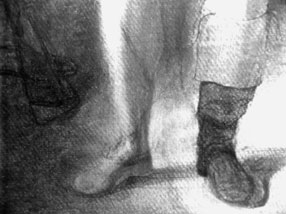Technical Notes
Before painting, Sully made a light pencil sketch on the primed canvas, describing the forms, contours, facial features, and other, smaller details (fig. 1). He applied a thin, semitransparent layer of reddish-brown earth-colored paint on top of the sketch in order to render the scene monochromatic. Colors were later added using a semitransparent, medium-rich paint, possibly one that contained a resinous component. The artist used opaque colors to create a low impasto in the tree roots and soil to the right of the figures. The overall brushwork is fluid, and most of the painting was done with a fine brush. An extensive network of fine age cracks, mostly corresponding to the weave pattern, occurs throughout. There is general surface abrasion, particularly along the slightly raised edges of the cracks. Before it entered the museum’s collection, the painting was consolidated and lined with a wax-resin adhesive. Small ridges in the paint surface are the result of the now flattened tenting. At the upper right, in the foliage, is a 2.5-centimeter scratch. Some of the uppermost glazes are damaged, especially the brown and green ones in the top-left center and the pink glaze in the sky. Dark vertical striations in the right foreground may be remnants of thinly painted grass or possibly staining in the underlying ground layers. Frame Notes |

